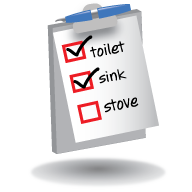Cleaning solutions are an integral part of keeping every home clean. There are cleaning mixture for general surfaces, glass, tubs, shower heads, dishwashers, and so much more. All these commercial chemicals add up to extra costs and a lot of bottles that need to be stored. A good alternative is to make your own homemade cleaning solutions.
There are several advantages to making your own concoctions. You generally only require a few different chemicals to make a homemade cleaning solution so there are fewer items to store. The cost of these combined products is often times less expensive than buying the store product. Spending less money is always good! And if you are a pro green supporter, using fewer products leaves less of a carbon footprint. Lastly, being able to make a cleaning solution from common household products can be very convenient.
Tub Surface Cleaner
Tub and shower surfaces are infamous for gunk that is difficult to clean. The buildup is a result of minerals in the water. Hard water carries lime and calcium traces that slowly collect on surfaces. Water softeners help to relieve the problem, but there will still be cleaning!
To create this cleaning mixture start with half a cup vinegar and heat for one to two minutes in the microwave. Dump the vinegar into a spray bottle and mix with ½ a cup of dish soap. Swirl the bottle just long enough to mix the vinegar and soap together. Spray on the surfaces of the tub or shower and wait for one to two hours. After waiting, scrub the surfaces with a sponge and water. The surfaces should clean right up and look much brighter.
Clog Fixer
Every household has had to deal with clogs. The best method is to prevent the problem before it occurs. Flush a one to two cups of vinegar down each month to clean buildup and watch what you flush down the drain. Items that are particularly bad are coffee grounds, and soap scum.
If you do get a clog and can not it with a snake, try a solution of vinegar, baking soda, and boiling water. First, drop a half cup of baking soda down the drain. Chase up the baking soda with two cups of vinegar. After the letting the mixture fizzle, flush it down with 1/2f a gallon of boiling water.
Try using a store bought product if the homemade solution fail to clear the clog. Call a plumber if that fails, too.
General Purpose Cleaner
For all-purpose purpose cleaning, or if you can not find a specific cleaner, use this mixture. Again, it is made from easy to find everyday household ingredients. Gather baking soda, vinegar, and water. Dump ¼ bup of baking soda into an empty spray bottle. Then, pour in a ½ cup of vinegar. These two will fizzle together. Lastly, pour in 2 cups of water. Heat the water if you plan to use the mixture for immediate use. Make sure to label the bottle so there is no confusion about the solution in the future.
Summary
There are plenty more mixtures out there to help you keep your house clean. The main thing to focus on is the common ingredients: vinegar, baking soda, and water. Typically, at least one of the three are found in a homemade cleaning solution. These solutions should help you for all the
cleaning scheduled for your house.


